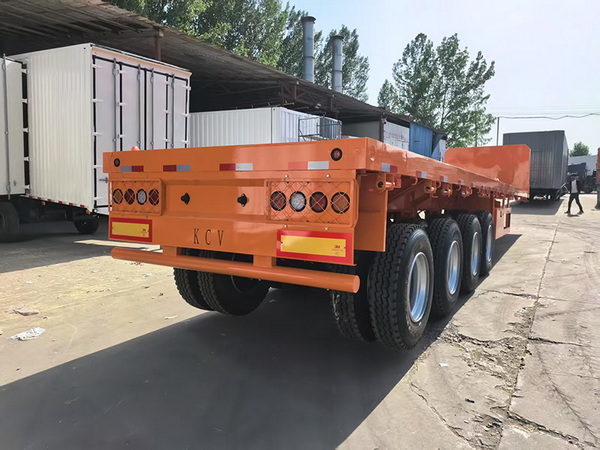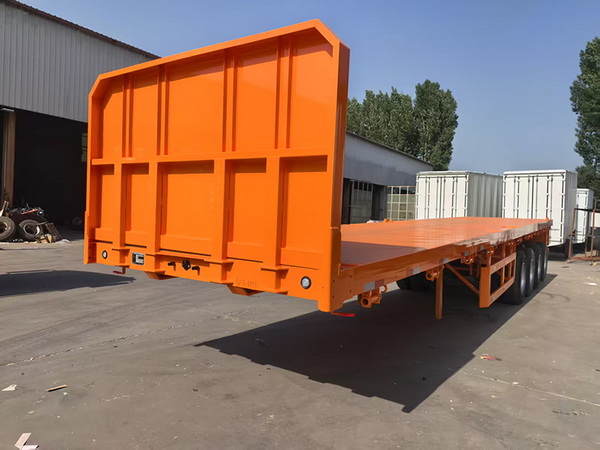Views: 222 Author: Amanda Publish Time: 2025-11-15 Origin: Site








Content Menu
● Semi Trailer Fundamentals for Livestock Hauling
>> Common Specifications and Configurations
>> Types of Livestock Trailers
● Calf Loading Densities and Trailer Calculations
>> Determining Livestock Density
>> Sample Capacity Calculation
● Factors Affecting Semi Trailer Capacity
>> Trailer Design and Innovative Features
>> Environmental and Regulatory Considerations
● Animal Health and Pre-Transport Considerations
>> Preparing Calves for Transportation
>> Handling and Loading Advice
● Regulatory Standards and Transport Compliance
>> Load Restrictions and Welfare Guidelines
>> Legal Liabilities and Responsibilities
● Innovations in Semi Trailer and Livestock Logistics
>> Modern Semi Trailer Technology
>> Sustainable Transport Practices
● Operational Logistics: Loading, Transit, and Unloading
● The Business Value of Optimizing Semi Trailer Capacity
>> Strengthening Animal Welfare Reputation
● Frequently Asked Questions (FAQ)
>> 1. How do I calculate the number of calves my semi trailer can transport?
>> 2. What are the most important regulations for transporting calves by semi trailer?
>> 3. Can overloading a semi trailer risk calf welfare or legal issues?
>> 4. What trailer innovations improve calf transportation?
>> 5. What is the best way to prepare calves for transport?
Transporting livestock, particularly calves, is a fundamental aspect of modern agriculture and commercial farming. As one of China's top commercial vehicle suppliers, KeyChain Venture Co., Ltd. delivers high-performance semi trailer solutions for both domestic and international customers, enabling efficient shipment and outstanding animal welfare. Understanding how many calves can fit on a semi trailer requires an in-depth knowledge of semi trailer design, regulatory standards, animal welfare principles, and logistical planning. This comprehensive guide explores these topics to help farmers, ranchers, and logistics professionals optimize their livestock operations through safe, legal, and efficient calf transportation.[1][6][10]

Semi trailers built for livestock are robust, spacious, and designed to maximize both capacity and animal comfort. The most frequently used models for calf transport are between 48 and 53 feet long, 8.5 feet wide, and up to 13.5 feet high, sometimes featuring double-deck layouts for increased capacity. The internal design may be adjusted with partitions or gates, which allows operators to create separate compartments for different groups, sizes, or breeds of calves to minimize injuries and stress.[5][6][1]
- Gooseneck trailers: Attach to truck beds, provide excellent stability, are popular for hauling moderate herds.
- Bumper pull trailers: Connect via a rear hitch, suitable for short-range, lighter loads.
- Double-deck trailers: Increase capacity, particularly for weaned calves; often used in commercial, large-scale operations.
- Stock trailers: Feature open sides for ventilation. These are versatile and widely used for farming.[10]
The main factor that determines how many calves fit on a semi trailer is the weight and size of each animal. Industry-accepted guidelines suggest allocating 3.5–6.5 square feet per 400 lb calf, ensuring that the animals can stand, lie down, and move comfortably. Overcrowding is not only illegal but also puts the health and safety of the animals at risk.[3][11]
A standard double-deck, 53-foot livestock semi trailer offers up to 900 interior square feet (two decks). Using a density of 6.5 square feet per 400 lb calf:
- One deck: 450 sq ft / 6.5 sq ft per calf ≈ 69 calves
- Double deck: 138 calves
For slightly larger calves (600 lb), the per-animal requirement may increase to 8.5 sq ft, lowering maximum headcount. Always abide by legal axle and gross vehicle weight limits, typically 80,000 lbs in China and North America, including tractor and semi trailer weight.[4][1][3]
Each calf's age and breed can impact the space needed; larger species like beef calves require more space than smaller dairy breeds. Calves must be healthy, able to stand and walk unaided, and should be grouped by size and temperament.
Advanced features such as slatted floors for improved traction, partition gates for segmenting loads, and adjustable air and water systems create safer conditions and can permit optimal density by reducing risks of injury. Purpose-built livestock semi trailers offer practical elements—a roll-up rear door, side ventilation slots, integrated ramps, and high-visibility lighting.[6][5]
In extreme temperatures, trailer capacity should be reduced to allow for additional air circulation and movement. Regulatory standards require drivers to carry documentation showing compliance with animal welfare rules, including journey times, rest periods, and space per animal.[12][13]
- Gradually reduce feed 12 hours prior to transport to minimize digestive stress.
- Inspect and treat for illness or injuries.
- Calves should be fit, alert, and accustomed to being handled.
- Segregate calves by weight, age, and breed to minimize aggression.
- Use non-slip loading chutes and ramps.
- Encourage slow, calm movement.
- Avoid mixing large and small calves in one compartment; reduce stress and chance of trampling.
- Monitor animals closely during loading and make space adjustments as necessary.
Regulatory authorities in China, North America, and Europe mandate maximum stocking densities and legal weight limits for safety and welfare.[11][13][14][12]
- Journey duration: Most laws cap single-trip time at 12–14 hours for young calves, with mandatory rest, food, and water periods.
- Documentation: Transporters must maintain logs and animal health certifications.
- Checkpoints: Frequent inspections monitor for injuries, illness, or non-compliance.
Violating transportation standards results in penalties, animal mortality, and business risk. Commercial transporters must proactively ensure that semi trailer capacity and load weights are within safe, legal ranges.

Manufacturers now provide customizable semi trailer options: modular compartments, double-deck loading, automated climate and hydration systems, specialized ramp systems, and lightweight but durable construction materials. These enhancements streamline loading/unloading and reduce the risk of injury, allowing more calves to be safely transported.[2][5][6]
Adopting proper cleaning/disinfection schedules and using recyclable materials aligns with global sustainability standards and supports animal health by minimizing disease risk.
- Group calves for each compartment by weight and age.
- Load heaviest or most restless animals first to minimize agitation.
- Ensure an even weight distribution to prevent trailer sway or tilt.
- Regular checks on animal comfort (especially for temperature and ventilation).
- Plan for scheduled stops—especially for journeys exceeding four hours.
- Ensure secure gates at all times to prevent escapes.
- Always unload calves as soon as possible at destination.
- Use gentle persuasion, avoid physical coercion.
- Inspect post-journey for injuries, dehydration, or signs of stress.
By maximizing legal and ethical use of semi trailer space, commercial cattle companies lower per-head transport costs, reduce trips, and improve overall efficiency. Well-managed logistics also reduce the risk of animal loss or injury, further boosting economic returns for each transport operation.
Adhering to space, welfare, and safety guidelines not only avoids regulatory penalties but boosts the reputation of the transporter and the end producer, opening more international markets.
Calculating how many calves can fit on a semi trailer requires careful attention to trailer specifications, calf size and health, industry best practices, and legal obligations. For the standard 53-foot double-deck semi trailer, the optimum practical capacity ranges from 100 to 150 weaned calves, depending on precise animal sizes and space allocation needs. Loading strategies, operational discipline, innovative trailer technologies, and commitment to animal welfare are all crucial to ensure safe, efficient, and compliant livestock transportation. Companies like KeyChain Venture Co., Ltd. continue to innovate in semi trailer design to meet the evolving demands of livestock logistics, blending robust engineering with best-in-class animal transit standards for the global market.[13][1][3][5][6][10]

Calculate the internal square footage (length x width) of the trailer and divide by the recommended space per calf (typically 6.5 square feet for 400 lb weaned calves). Adjust for calf size, trailer compartment layout, and legal weight limits to ensure safe, comfortable transit.[1][3][10]
Critical regulations include limiting journey durations to 12–14 hours without rest, ensuring all calves are healthy and fit for travel, maintaining proper documentation, and meeting country-specific density and vehicle weight restrictions.[11][12][13]
Overloading can lead to crowding injuries, increased mortality, higher disease risk, and potential legal penalties. Operators must always comply with animal welfare and load density guidelines.[14][3][13]
Modern semi trailers offer double-deck layouts, enhanced ventilation, water and feeding systems, non-slip floors, and modular gates to enhance comfort, loading efficiency, and safety.[2][5][6][10]
Gradually reduce feed before departure, inspect and treat for illnesses, and handle calves gently during grouping, loading, and unloading. Always monitor animal condition before, during, and immediately after transport to prevent stress and injuries.[15][13]
[1](https://semitrailer.by/how-many-cows-fit-on-a-semi-trailer-a-comprehensive-guide/)
[2](https://www.mheby.com/product/bull-ride-livestock-semi-trailer)
[3](https://www.bqa.org/Media/BQA/Docs/bqa-mature-cattle-hauling-loading-density-guidelines-updated_51523.pdf)
[4](https://www.tractortransport.com/livestock-trailer-transport.php)
[5](https://www.barrett-trailers.com/semi-trailer)
[6](https://www.fthr.com/product/livestock-trailers/semi/)
[7](https://www.freightcenter.com/types-of-semi-trailers/)
[8](https://www.transwest.com/trailers/blog/semi-trailer-dimensions-length-and-what-can-you-haul/)
[9](http://ablamb.ca/producer_mgmt/Setting-It-Up-Sheep-Infrastructure/6-Handling-Systems/C-Transportation-and-Other/6-21-Livestock-Trucking-Guide.pdf)
[10](https://www.fourwindstrailers.com/blog/cattle-trailer/)
[11](https://www.bqa.org/Media/BQA/Docs/bqa-calf-hauling-loading-density-guidelines-updated_51523.pdf)
[12](https://www.beefresearch.ca/blog/updated-livestock-transport-regulations/)
[13](https://www.grandin.com/meat.association.institute.html)
[14](https://www.bqa.org/Media/BQA/Docs/bqat-manual_02-10-2021-91.pdf)
[15](https://www.thebullvine.com/news/your-calf-transport-shortcuts-are-bleeding-your-dairy-dry-the-high-cost-of-get-em-gone-thinking/)